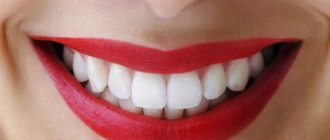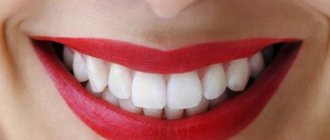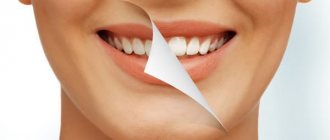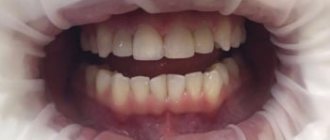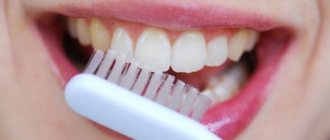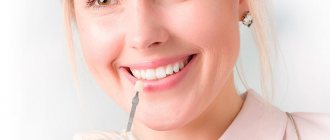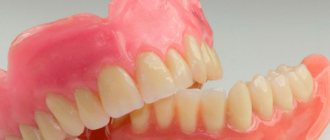Doctor's consultation The topic of whitening has captured everyone's attention: from schoolchildren to pensioners. Everyone wants a snow-white smile - a symbol of well-being, success in life, and health. Marketers offer a thousand and one ways to instantly achieve an effect, modestly keeping silent about the essence of the procedure, about contraindications and negative consequences of teeth whitening.
So is it necessary to follow fashion, is teeth whitening harmful to health and why it is performed only under the supervision of a doctor - the opinion of dentists on “hot” issues.
A beautiful smile is the key to success!
The main wealth of a person at all times is his health.
And recently it has also become a criterion of well-being and wealth. Every day more and more people focus their attention on the condition of their teeth and the beauty of their smile, because this is a requirement of the time and one of the components of the image of a prosperous person. Thanks to the tireless work of dentists throughout our country and constantly flashing commercials on television, the value of healthy teeth, fortunately, has become clear to our people. Having left the panic fear of the dentist's office in the distant past, we are paying more and more attention to our teeth. Requirements have increased both for the quality of the treatment and the absence of pain, as well as for improving the aesthetic component of the result: the shape, color and naturalness of the teeth. Many patients complain about the dark color of their teeth, pigments and stains on the enamel that cannot be removed with toothpaste and a brush. It is not advisable to cover teeth with crowns or composite and ceramic veneers - veneers, since this requires removing a layer of enamel, that is, grinding the tooth. To solve the problem of teeth whitening, there are various techniques that we would like to introduce you to. the mechanical cleaning
method , which includes professional oral hygiene, and
the chemical whitening method
, which is based on the occurrence of oxidative processes that arise as a result of the action of atomic oxygen on the natural tissues of the teeth.
What harm can bleaching cause?
The safest teeth whitening will be under the supervision of a professional dentist. Indeed, with inept management and the wrong approach, a number of troubles can arise:
- Negative effects on tooth enamel of incorrectly selected concentrations of bleaching agents. This is both increased sensitivity and an increase in the microporosity of its structure. Over time, the ingestion and accumulation of food dyes may cause the tooth color to become even darker than before;
- chemical burn of gum tissue due to improper isolation;
- uneven lighting.
Professional oral hygiene
Everyone has probably heard about teeth whitening using Air-Flow in one day.
Advertising is advertising. Using the AirFlow air-abrasive handy blaster system, produced by the Swiss company EMS, or similar systems from other manufacturers, such as Profy Mate (NSK), Profy Jet (Densply), etc. Mechanical cleaning of pigmented plaque (especially smoker’s plaque) and polishing of the tooth surface are carried out in combination with the removal of dental plaque. This event is mandatory when carrying out sanitation of the oral cavity, prevention and treatment of periodontal diseases (support-retaining apparatus of the tooth). In the photographs we see teeth cleaned of plaque and polished, which have been restored to their natural color using mechanical cleaning; however, it is impossible to change the color of the enamel, making it several shades lighter, which, in fact, is what teeth whitening is, is impossible with this method. AirFlow or systems similar in their method of action are used in preparation for whitening - they are used to remove dental deposits, stones and hard plaque, otherwise the “bleach” simply will not penetrate through them.
How does the procedure work?
The main preparation before the whitening procedure, which guarantees uniform lightening of the enamel, is teeth cleaning (“Air Flow” and ultrasound). Professional whitening is carried out in a regular dental chair. Initially, it is necessary to isolate the mucous membrane so that the bleaching agent does not come into contact with it. Next, the doctor applies it to the teeth (for about 20 minutes) and uses a special lamp. This procedure is repeated several times, completely washing off the composition. The average duration of the entire procedure is 1.5 hours. It does not cause any painful sensations. Some patients feel a slight tingling sensation - this is a normal reaction.
The procedure has a cumulative effect - oxygen continues to work on the teeth behind the doors of the dental office. The final result can be assessed after 1-2 weeks. It is important to adhere to a “white” diet for the first 2-3 days after the procedure: give up coffee, black tea, red wine and any coloring products. The resulting effect will last about 2-3 years (if you regularly sign up for professional hygiene every six months).
What is whitening?
We will talk about bleaching - a chemical oxidation process, as a result of which, under the influence of oxygen, organic substances are broken down into carbon dioxide and water. During oxidation, organic substances are oxidized to intermediate products that are lighter than the original ones. During this reaction, the oxidizing agent (substance H2O2 - hydrogen peroxide), which has a free radical with a non-polar electron, gives it to the oxidized substance. The substance being bleached accepts a non-polar electron and is thus oxidized. The low or high percentage of strong free radicals depends on the acidic or alkaline environment in which the ionization process occurs. Back in the middle of the second half of the 19th century, articles were published about teeth whitening under the influence of hydrogen peroxide. Currently, modern bleaching systems use carbamide peroxide, chlorides, urea peroxide and hydrogen peroxide, one of the decomposition products of which is atomic oxygen. The intensity of tooth color is determined by the number of paired C=C compounds. Oxidation leads to the formation of a simpler, single carbon compound, which reduces pigmentation, i.e. teeth whitening. Whitening does not affect the surface of fillings and artificial crowns, so after it is completed, color differences may appear, to eliminate which replacement of the fillings or crowns covering the teeth is indicated.
Whitening strips
The principle of operation of the strips is very similar to the mechanism of a pencil. These are special soluble or insoluble strips that are fixed on the visible surface of the teeth in the smile area and left for the recommended time, during which the active substance based on hydrogen peroxide penetrates the top layer of tooth enamel and brightens it.
Why do teeth change color?
The color of teeth is polychromatic, it changes in the areas of the neck, cutting edge and area of contact with the gum, depending on the thickness, degree of reflection of various shades and translucency of the enamel and dentin (inner part of the tooth).
In addition, changes in the color of enamel are affected by: - the predominance in food of products that have a strong coloring effect: coffee, strong tea, Coca/Pepsi-Cola, blueberries, blackberries, red wine, soy sauce (staining the tooth from light brown to black) ; - smoking tobacco. Nicotine and a high content of various tars (even in the lightest cigarettes) cause the enamel to stain from yellow-brown to black; — medicinal effects of drugs during the period of tooth formation. (antibiotics, especially tetracycline); — chemical influence (increased fluoride content in drinking water leads to a disease called fluorosis);
— genetic predisposition (hereditary factor and systemic diseases suffered at an early age); — incorrect dental intervention and complications; - age-related changes in tooth color. All of the above reasons that cause discoloration of teeth are indications for whitening.
“Making beauty” at home
Home whitening methods use individual dental trays for whitening gel, the concentration of which varies between 9-22%. Despite the fact that the home method is relatively slow and is carried out over 2-6 weeks (depending on the severity of the condition and some features of the structure of the tooth enamel, for example, with a disease such as fluorosis), the result is almost always wonderful. There is rarely any change in tooth sensitivity, which is quickly restored after the procedures are completed. Teeth, while lightening, retain the natural coloring of the entire surface and do not change their natural appearance. The desired effect is not always achieved only in teeth with tetracycline pigmentation and other types of color changes in the deep tissues of the teeth.
Common myths about teeth whitening
The whitening procedure is surrounded by quite a lot of myths and not entirely correct opinions. Below are the most common ones.
- “Whitening harms tooth enamel.” Today there is practically no debate about whether whitening is harmful to tooth enamel. Does teeth sensitivity increase after whitening? Yes. Does enamel deteriorate? No. Recent studies indicate that frequent whitening procedures can lead to demineralization of the enamel and a decrease in its protective functions (especially with a high concentration of the active substance). That is why experts carry out a remineralization procedure after bleaching, and also recommend avoiding cold and hot foods in the first days. However, it cannot be said that hydrogen peroxide destroys enamel. That is why this statement falls into the category of misconceptions.
- “Whitening results last a lifetime.” This is one of the most common myths associated with teeth whitening. If all recommendations are followed and supportive measures are taken, good teeth color can be maintained for many years, but over time it will still fade somewhat. Moreover, the statement that teeth can be whitened by 10-12 shades is also more of a marketing ploy than the truth. The exact figures depend on several factors, including the individual characteristics of the patients' teeth. In reality, lightening by 8 tones (even with in-office bleaching) is an almost ideal result.
- “Photobleaching is more effective than chemical bleaching.” Some people believe that activating a substance using an ultraviolet lamp allows you to achieve much better results, but this is not so. Of course, a lot depends on the manufacturer, but if we compare the top systems Zoom (photo whitening) and Opalescence (chemical whitening), they are approximately equal in terms of efficiency. This is confirmed by patient reviews.
- “Fillings and crowns can also be whitened.” Unfortunately, this is a myth. That is why the presence of many fillings and crowns (especially in the frontal area) is a limitation for whitening.
- “You don’t have to go to a dental clinic for whitening services.” Professional whitening is carried out only in a dentist’s office in specialized clinics, otherwise there is a risk of not only not getting the desired result, but also of developing a number of serious complications (burns, poisoning, and so on). Home whitening kits can be used outside of a clinic, but even then, it is recommended to consult with a specialist first.
Professional approach
Our clinic prefers the OPALESCENCE whitening system manufactured by Ultradent. We also use in practice and offer patients Rembrandt oral hygiene products. Opalescence, Rembrandt and Colgate are among the few whitening systems that are recognized and trademarked by the American Dental Association (ADA). The Opalescence teeth whitening system is registered by the Ministry of Health of the Russian Federation. Opalescence gel contains 20% water, which helps to avoid hypersensitivity or reduce it, without drying out or dehydrating the enamel. The active ingredient in the Opalescence system is carbamide peroxide. Whitening pastes contain various flavoring additives - neutral, banana, menthol and watermelon flavors. Various concentrations of urea peroxide are available (Opalescence 10%, 15%, 20%) with and without fluorine. 35% Opalescence X-tra with carotene is intended for whitening only in the doctor's chair. The procedure for using the home version of Opalescence is not complicated, but requires strict adherence to the instructions. On the first visit, the dentist determines the initial color of the teeth, studies the medical history, removes dental plaque, and takes impressions of the dentition for subsequent production in the laboratory of individual aligner reservoirs in which the whitening gel will be placed. On the second visit, the mouth guards are tried on, they are adjusted, the patient is taught the technique of applying the gel, the procedure for use, the daily or night protocol for use is explained, and a particular toothpaste is recommended. On the third visit, the achieved result is assessed. The whitening effect is comfortable for the patient and others when the shade of the teeth is lightened by 2-4 tones. Attention!
Filling materials are not bleached. Old fillings need to be replaced, since the whitened teeth will be much lighter, but this should be done no earlier than after 14-15 days. During this time, all cabamide peroxide leaves the tooth tissue, and the shade of the enamel stabilizes. Then you can proceed to the restoration of teeth and select the shade of the composite material that matches the shade of the bleached enamel.
Why can't you whiten your teeth?
Contraindications to teeth whitening are: - the presence of an allergic reaction to hydrogen peroxide or other components of the drug used for whitening; - lightening of superficial pigment spots, which can be easily removed with professional teeth cleaning and proper oral hygiene; — a large number of carious areas, defective fillings, periodontal diseases in the active stage, abundant dental plaque (in this case, you must first undergo oral sanitation); - pregnancy or breastfeeding; - excessively enlarged pulp chamber. Not recommended for children and teenagers.
Teeth whitening: harmful or not?
The procedure is part of cosmetic dentistry, but does not cease to be a medical service. That is why the answer to the question of whether teeth whitening in dentistry is harmful is obvious. When carried out correctly and using certified products and technologies, cosmetic teeth whitening does not pose a health hazard. This is the opinion of experts and researchers.
A beautiful smile is the key to success!
Smile with us! The dentists at our Center will help you make your smile sparkling for a long time. The department is equipped with the latest technology and has everything necessary to perform high-quality work: a modern dental complex, high-quality X-ray equipment and the latest generation materials. Each patient is guaranteed high-quality treatment and an individual approach to teeth whitening. If, after whitening, you need to replace old fillings with defects with new ones or cure caries, all these problems can also be solved in our dental department.
Remember that beautiful teeth are your calling card in our modern world!
How safe is chemical bleaching?
Chemical bleaching is completely safe for the patient’s health. This is possible thanks to the use of high-tech equipment and modern bleaching agents that do not provoke negative reactions from the human body. For the procedure to be effective, it must be performed by an experienced dentist in a specialized, trustworthy clinic. Also, you should not have any contraindications for carrying out any manipulations to lighten dental tissues. Following all doctor’s recommendations, regular consultations and careful oral care will give you a radiant smile and keep it white for a long time.
